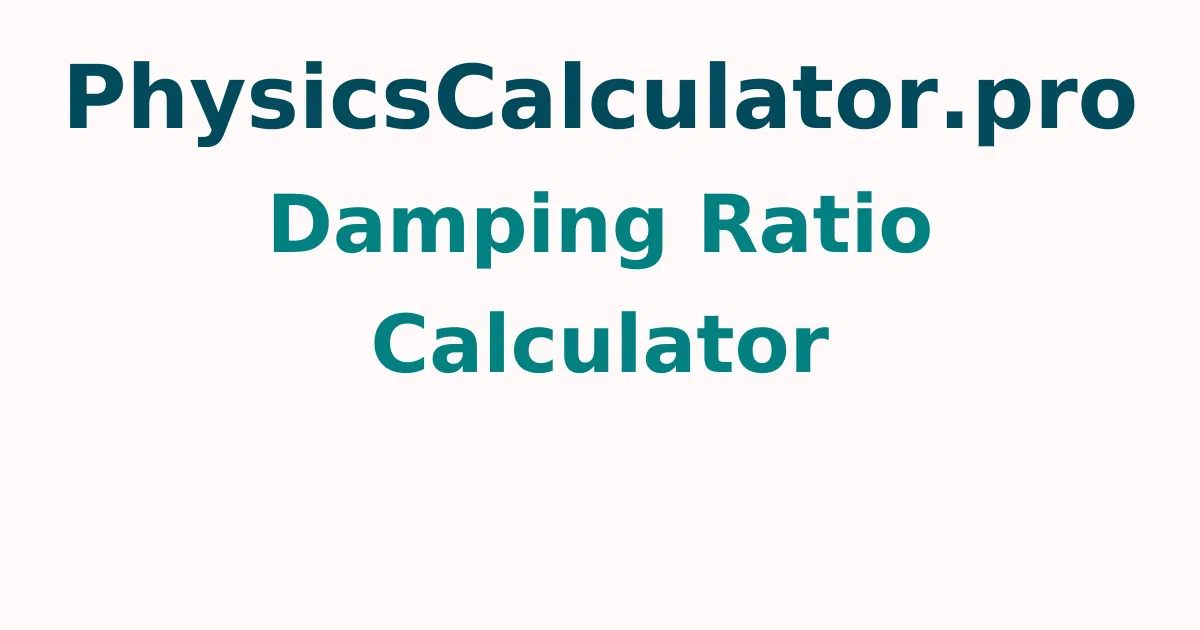Damping Ratio Calculator
You can use the damping ratio calculator to examine damped oscillatory systems. Don't worry, there are three ways to compute the damping factor, so no matter what variables you know (or need to find - our calculator also works in reverse! ), we've got you covered.
What is meant by Damping?
Consider an oscillating instrument like a pendulum to get a sense of what damping is. If you leave it alone, it will ultimately stop moving in a harmonious manner. The reason for this is that frictional forces with the air and at its pivot will deplete its mechanical energy (the total of its potential and kinetic energy). You can see this since the amplitude of the pendulum decreases with each swing. Such motion is referred to as damped motion, and this type of pendulum is referred to as a damped harmonic oscillator.
As a result, there are four different types of oscillatory systems:
Underdamped - Underdamped amplitude decreases with time because damping is insufficient. When a damped harmonic oscillator (such as a pendulum) is left to its own devices, this is what happens.
Overdamped - When an object is overdamped, it fails to complete even a single oscillation, and its velocity approaches zero as it approaches equilibrium (rest). A pendulum dipped in a sticky liquid, such as honey, provides a good example.
Critically damped - comparable to overdamped, but the item reaches equilibrium more quickly. The damping, as well as the minimum value for non-oscillatory motion, are both just correct. It would be underdamped if it was any less.
Undergoing simple harmonic motion - There is no damping when moving in a simple harmonic motion. The oscillator continues to move indefinitely, exchanging kinetic and potential energy.
The damping factor of a system controls how quickly mechanical energy is lost and the object returns to its original position. How do you calculate the damping coefficient? It is an inherent attribute of the spring that is usually discovered by calculating the amplitude decay rate or deriving it from other parameters.
What can we deduce from the Damping Factor - Recognizing the Outcomes
The damping ratio aids in determining which scenario of damped motion we're dealing with. The table below will assist you in deciphering the findings of the damping ratio calculator.
|
Damping ratio (ζ) |
System |
|
ζ < 1 |
Underdamped |
|
ζ = 1 |
Critically damped |
|
ζ > 1 |
Overdamped |
It's important to note that the damping factor can't be negative.
In ordinary life, there are a variety of damped oscillations.
Although the pendulum is the most common and simplest example, it does not appear to be particularly relevant to most of us - at least not at first. After all, few individuals possess a traditional standing clock, and even fewer use seismometers or gravitometers. However, you may come into various types of oscillators, some of which are given below:
- As seismic isolators, friction pendulums are utilized. To put it another way, they shield structures from earthquakes. The pendulum sways according to ground movement, lowering the possibility of structural damage. The building could keep moving long after the earthquake if there was no dampening. Residents may not wish to dwell in such a large space.
- Door dampers slow the door down, preventing it from slamming down and producing noise. This is a system that is overdamped. The damper must be more robust if the door is huge (e.g., burglar-proof), as can be determined from equations 2 and 3.
- Surprisingly, speedometers in automobiles. After all, it's a deal with a needle pointing to the vehicle's immediate speed; where are the oscillations? This is an example of crucial damping, as it turns out. The pointer might otherwise vibrate or travel too slowly to achieve the correct value. Now you'll know what's causing your problems if you ever experience them!
- Swings are basically pendulums that are more enjoyable, as we now know. Some amusement park rides that can sway vertically would be a more sophisticated variation. To induce the body to oscillate in both circumstances, you'll require a driving force. The swing will finally stop moving if you stop pumping after that. Of course, by tinkering with the pendulum's parameters, you can influence how soon that occurs.
FAQs on Damping Ratio Calculator
1. What is the purpose of the damping ratio?
The damping ratio (also known as damping factor or percent critical damping) is used to characterize the degree of damping in a system. This damping ratio is just the difference between the actual damping and the damping required to reach critical damping. For the mass-spring-damper model, the damping ratio formula is utilized.
2. What does a one-to-one damping ratio imply?
The damping ratio is defined as follows: An overdamped system returns to rest slowly and without oscillations when the value is greater than 1. A system with a damping factor of less than one oscillates back to rest. A critically damped system returns to rest rapidly without oscillating when its value is equal to one.
3. What constitutes a satisfactory damping factor?
Damping factors of ten or more are acceptable, with numbers in the 50-100 range being a decent average, but numbers as high as 200 or 300, or even into the low thousands, are occasionally seen.
4. What factors determine whether a system is underdamped or overdamped?
An overdamped system takes a long time to return to equilibrium. An underdamped system will reach equilibrium rapidly, but it will oscillate around the equilibrium point in the process. A critically damped system approaches equilibrium as rapidly as feasible without oscillating about it.
5. What does it mean to have a viscous damping ratio?
The viscous damping coefficient (measured in N s/m) is a theoretical parameter that can explain how friction dissipates energy and slows motion. It is not a real physical parameter like the mass m or the spring constant k, which can be measured easily.
